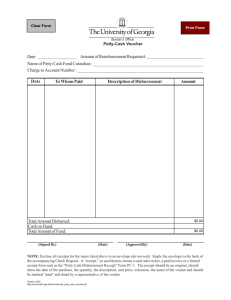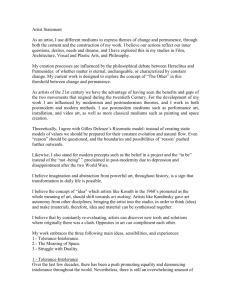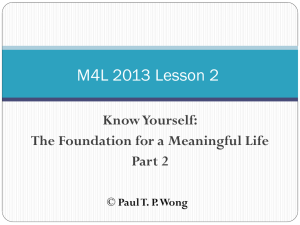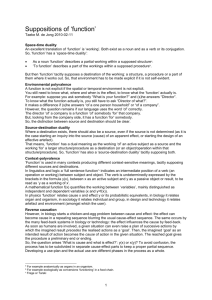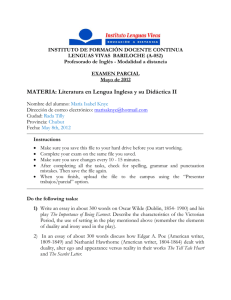Chapter 1
advertisement
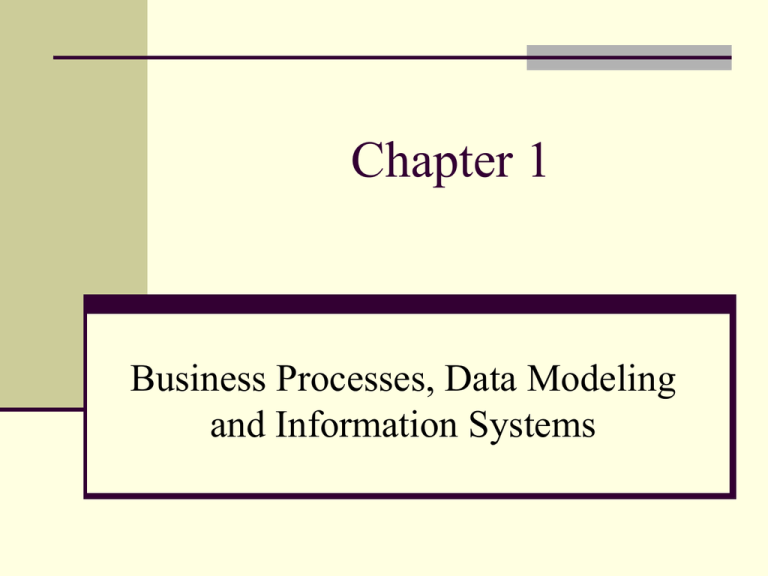
Chapter 1 Business Processes, Data Modeling and Information Systems Learning Objectives Identify entities and relationships in a business process Identify resources, events and agents (REA) in a business process Evaluate and determine the cardinalities Model a company’s business processes using an REA diagram Legacy versus Modern AIS Legacy accounting information systems Flat files with disconnected subsystems Modern accounting information systems Use database approach that emphasizes the integration and sharing of data across major functional areas Designed based on a company’s business processes Event-driven based upon business processes What is Data Modeling? The process of creating a logical representation of the structure of a database based on a company’s business processes The most important task in the development of an effective database is to provide useful information Entity-Relationship Diagram Entity-Relationship Diagram (ERD) is a commonly used business data modeling technique. The ERD uses a graphical representation to identify and document various entities and the relationships between those entities. Three major components of an ERD are the entity, the relationship, and the attribute. ERD An entity is anything about which a company would like to collect and store information. Example: inventory, purchase, vendor, etc. It is represented using a rectangle. A relationship is an association between entities. Example: one-to-one, one-to-many It is represented using a diamond. An attribute is a characteristic of an entity, such as the inventory number and the description of each item in the entity of “inventory.” Resource-Event-Agent (REA) Diagram REA diagram is a framework specifically designed for building accounting information systems in a shared data environment based on the ERD technique. Components in an REA diagram: Resources: Things that have economic value to a company, such as cash and inventory. Events: Various business processes conducted in a company’s daily operations, such as sales and purchases. Agents: People and organizations, such as customers and salespeople, who participate in business events. REA Diagram Figure 1-1 The REA Pattern* Resource Economic Resource A Events Agents Inside participation Economic Agent I Outside participation Economic Agent II Economic Event Inflow Get Resource A Economic duality Economic Resource B Inside participation Economic Agent III Outside participation Economic Agent IV Economic Event Outflow Give Resource B A general rule: each economic event should be linked to at least one economic resource and two economic agents. The relationship shown between the two economic events is referred to as an economic duality relationship. The causal relationship occurs as a result of a give and a take happening. Basic Economic Events in Transaction Cycles Figure 1-2 Basic Economic Events in Transaction Cycles Revenue Cycle Expenditure Cycle Human Resource/ Payroll Cycle Financing Cycle Sale Purchase Labor Acquisition Cash Receipt Duality Duality Duality Duality Cash Receipt Cash Disbursement Cash Disbursement Cash Disbursement Conversion (Production) Cycle Finish Goods Inventory Duality Duality Duality Labor Operation Machine Operation Material Issurance Transaction Cycles and REA Modeling The transaction cycles are combined into an REA model to create the entire accounting information system (see Figure 1-3). This high-level conceptual model indicates how the transaction cycles interact with each other and with the financial reporting system. Overall REA Model for an AIS Figure 1-3 Overall REA Model for an Accounting Information System* Human Resource/ Payroll Cycle Financing Cycle Labor Acquisition Cash Receipt Duality Cash Duality Cash Disbursement Cash Disbursement Cash Cash Revenue Cycle Expenditure Cycle Data Data Sale Purchase Data Data Financial Reporting System Duality Cash Receipt Duality Cash Disbursement Data Labor Finished Goods Materials Conversion (Production) Cycle Finish Goods Inventory Duality Duality Duality Labor Operation Machine Operation Material Issurance REA: Revenue and Expenditure Cycles Figure 1-4 Sample REA Diagrams for Revenue and Expenditure Cycles Resource Inventory Events Inflow Agents Inside participation Purchasing Agent Outside participation Vendor Outside participation Vendor Inside participation Cashier Inside participation Salesperson Outside participation Customer Outside participation Customer Inside participation Cashier Purchase Purchase-Cash Disbursement Expenditure Cycle Cash Inventory Outflow Outflow Cash Disbursement Sale Sale-Cash Receipt Revenue Cycle Cash Inflow Cash Receipt Relationships between Entities has height Eric owns 5"8" Ben Vehicle#104 teaches John Lewis Person has Height Person owns Vehicle Professor teaches Course Marketing Cardinalities The number of instances one entity can be linked to one specific instance of another entity. Restricts the number of participation constraints in a relationship. A cardinality is denoted as (min,max) where min is the minimum number and max is the maximum number that can participate in a relationship. Person-Height Example (1,1) has Person Eric (0,N) Height 5'5" 5'6" 5'7" 5'8" 5'9" 6'0" 6'1" 6'2" Emily Michael Tina (1,1) Person has (0,N) Height Professor-Course Example (1,N) Professor John Lewis teaches (0,N) Mary James Alex Davis Jennifer Bell Professor (1,N) teaches Course Financial Accounting Business Law Linear Algebra Marketing Data Structure Calculus Database Management Computer Programming (0,N) Course Using REA to Model Business Processes Three basic steps to construct an REA diagram to depict a company’s business processes: 1) 2) 3) Identify economic exchange events. Identify the resources affected by each economic event and the agents who participate in those events. Determine the cardinalities of each relationship. After the business processes are modeled, the REA diagram should be validated by the company’s experts who are knowledgeable about the details and the objectives of the business processes. Sales-Cash Receipt Relationship (E-E) Identify economic exchange events in the cycle Sales Duality Cash Receipt Basic REA Diagram for Cherokee’s Revenue Cycle Identify the resources affected by each economic event and the agents who participate in those events Resource Inventory Agents Events Outflow Inside participation Jesse Outside participation Customer Outside participation Customer Inside participation Jesse Sales Duality Cash (Bank Account) Inflow Cash Receipt Cash-Cash Receipt Relationship (R-E) Determine the cardinalities of each relationship Cash (Bank Account) (1,N) (1,1) Inflow Cash Receipt Inventory-Sales Relationship (R-E) (0,1) Inventory (1,N) Outflow Sales Sales-Cash Receipt Relationship (E-E, without accounts receivable) Sales (1,1) Duality (1,1) Cash Receipt Sales-Cash Receipt Relationship (E-E, with accounts receivable) Sales (0,1) Duality (1,N) Cash Receipt Complete REA Diagram for Cherokee’s Revenue Cycle (1,N) (0,1) Inventory Inside participation Outflow Sale (0,N) Jesse (1,1) (1,1) (1,1) Outside participation (1,N) Customer Duality Outside participation (1,1) (1,N) (1,1) Cash (Bank Account) Inflow (1,N) (1,1) Cash Receipt (1,1) Inside participation (0,N) Purchase-Cash Disbursement Relationship (E-E) Identify economic exchange events in the cycle Purchase Duality Cash Disbursement Basic REA Diagram for Cherokee’s Expenditure Cycle Identify the resources affected by each economic event and the agents who participate in those events Agent Resource Inventory Event Inflow Inside participation Jesse Outside participation Artist/Seller Outside participation Artist/Seller Inside participation Jesse Purchase Duality Cash (Bank Account) Outflow Cash Disbursement Cash-Cash Disbursement Relationship (R-E) Determine the cardinalities of each relationship Cash (Bank Account) (1,N) (1,1) Outflow Cash Disbursement Inventory-Purchase Relationship (R-E) (1,1) Inventory (1,N) Inflow Purchase Purchase-Cash Disbursement Relationship E-E, with accounts payable Purchase (0,N) Duality (1,N) Cash Disbursement Complete REA Diagram for Cherokee’s Expenditure Cycle (1,1) Inventory (1,N) Inside participation (0,N) Outside participation (1,N) Jesse (1,1) Purchase Inflow (1,1) (0,N) Duality Artist/Seller Outside participation (1,N) (1,N) (1,1) Cash (Bank Account) Cash Disbursement Outflow (1,N) (1,1) (1,1) Inside participation (0,N) Comprehensive REA Data Model for Cherokee Art and Antique Store Expenditure Cycle Revenue Cycle (0,N) Inside Participation Inside Participation (1,1) (1,1) (1,N) (1,N) (1,1) Inflow Purchase (0,1) Inventory (1,N) Sale Outflow Outside Participation (1,1) (1,1) Outside Participation Duality (1,N) Outside Participation (1,1) (1,1) Inside Participation (0,N) Jesse (1,1) (0,N) Artist/Seller (0,N) (1,N) Customer Duality Outside Participation (1,1) (1,N) (1,N) (1,1) Cash Disbursement Outflow (1,1) Cash (1,N) (Bank Account) Inflow (1,N) Cash Receipt (1,1) (1,1) Inside Participation (0,N) End of Chapter 1
